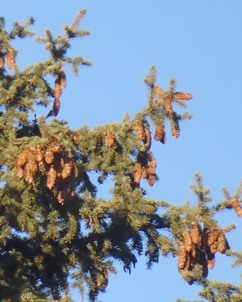Winter is the time of year when your landscape may look drab. Leaves have fallen off of the deciduous trees, most of the berries on fruiting shrubs have been eaten by the birds, and flowers have all died back for the year. It is at this time that we can really enjoy our coniferous trees, such as Norway spruce.
Norway spruce is a fitting choice as December's plant of the month, since it is often used for Christmas trees. Norway spruces are more pyramidal when they are young and they have a strong scent that makes them desirable for Christmas trees. . Norway spruce is also used in the manufacturing of wood products such as furniture, buildings, and musical instruments, according to the United States Department of Agriculture Forest Service.
Norway spruce, Picea abies, is a very large evergreen tree, growing up to 100 feet tall. It is a beautiful tree that looks very weepy in form even from a distance because the branches tend to have smaller branches that hang down, like pendulums, off the larger branches. Norway spruces have ½-1 inch long needles that are dark green with a couple of slender white stripes down the needle. Picea abies has very long cones, up to seven inches long, with flexible, thin scales.
According to Walter T. Bagley and Richard K. Sutton in their book Woody Plants for the Central and Northern Prairies, the many different varieties of Norway spruce have varying degrees of droopiness, height, and spread. The cultivar 'Argenteo-spica' has creamy white new shoots that turn green. 'Nidiformis,' also called bird's nest spruce, is a low growing, mound type that has a dip in the center to look like a bird's nest.
For those living on acreages, Picea abies can be used in landscapes as a specimen tree, a screen, or a windbreak. Norway spruce grows fairly fast and grows quite large, so it would make a great windbreak for its aesthetic quality as well. They do best in full sun with moist growing conditions. They are tolerant of wind, which makes them a great choice for a windbreak tree.
A Norway spruce in your landscape also adds to wildlife habitat. Birds and other smaller mammals can use the tree for protection from our strong winter winds. One good feature is that deer prefer to browse on other types of trees
Norway spruce, Picea abies, is a beautiful tree for any landscape; as it does get very large, an acreage is a good setting for it. These trees add a great deal of winter interest as well as habitat for the birds and other small animals that may be found on your acreage. It also makes for a beautiful windbreak. The next time you need to add winter interest or new windbreak trees to your landscape, try using Norway spruce.


